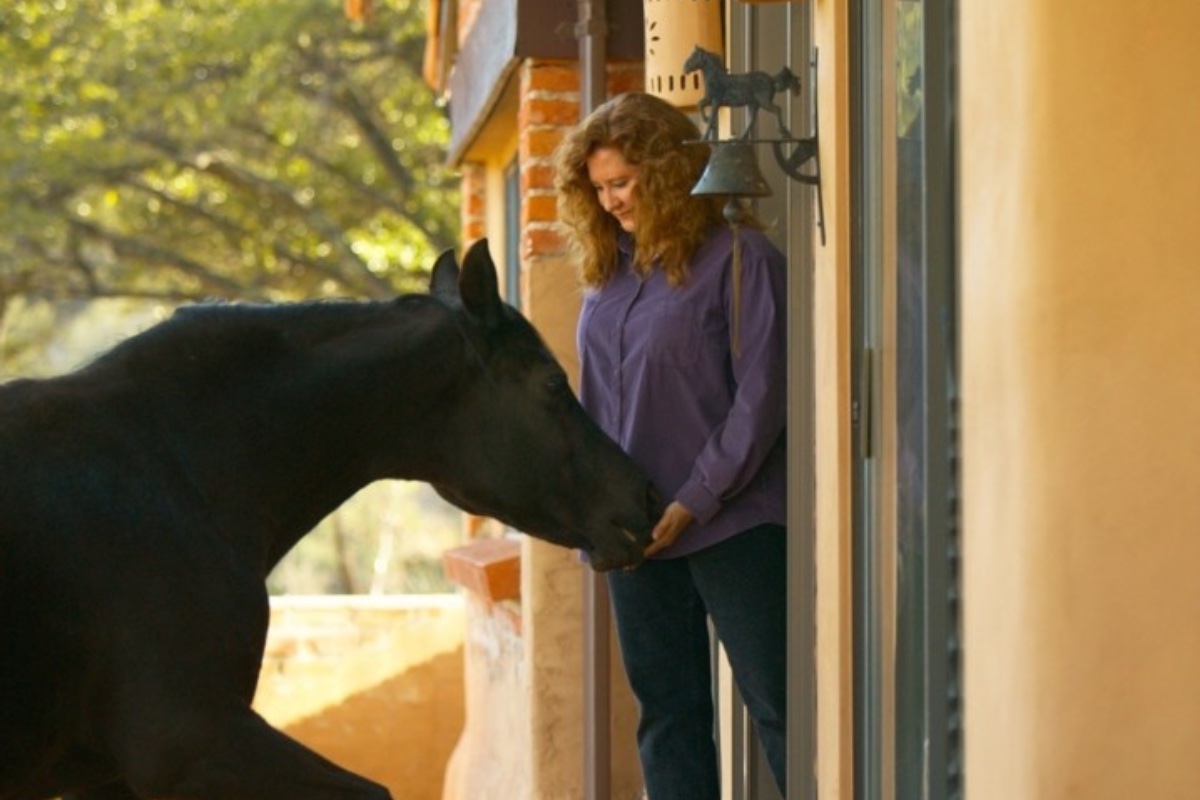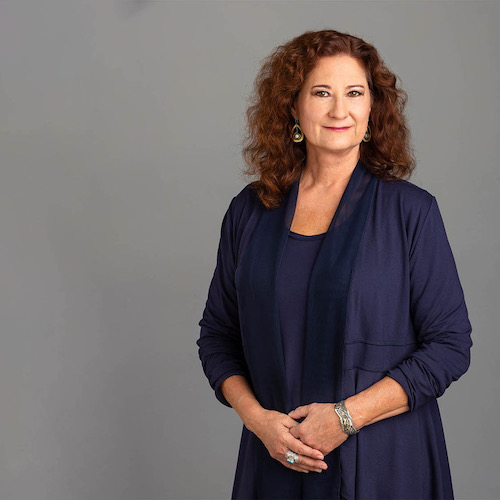
Yin and yang
Horses embody many of the attitudes people access through more formal meditation techniques, including the ability to engage fully with reality. What seems so difficult for a grasping, hoarding, controlling, and competitive human being comes easily to these highly social, intensely aware, nomadic prey animals. Horses are hardwired for the state of nonattachment championed by the Buddha. In the wild, they don’t defend territory, build nests, live in caves, or store nuts for the winter. They move unprotected with the rhythms of nature, cavorting through the snow, kicking up their heels on cool spring mornings, grazing peacefully in fields of flowing grass, despite a keen and constant awareness of predators lurking in the distance.
While they react quickly in the face of danger, they also show remarkable resilience in recovering from traumatic events. Yet unlike rabbits and other small vegetarians, adult horses are dangerous prey, using the power of the herd to successfully protect vulnerable members from wolves and lions. Still more impressive, horses have fought in the absolute bloodiest of human wars, sometimes receiving medals for exceptional bravery.
Horses embody a different approach to power, modeling the strengths of nonpredatory behavior: relationship over territory, process over goal, responsiveness over strategy, cooperation over competition, emotion and intuition over reason. And yet, they can be focused and assertive when the situation calls for it. They quite literally follow the ancient Taoist recommendation to “Know the yang, but keep to the yin,” which often appears in translation as “know the masculine, but keep to the feminine.” The Chinese sage Lao-tzu made this recommendation in the Tao Te Ching over 2,500 years ago, yet conquest-oriented civilizations emphasized the opposite. When a culture, like ours, keeps to the yang, discounting and degrading the yin, our ability to harmonize with other people, let alone nature itself, is seriously compromised.
Horses demand a balance of strength and sensitivity. As nineteenth-century trainer Dennis Magner observed, working with horses requires “the delicacy of touch and feeling of a woman, the eye of an eagle, the courage of a lion, and the hang-on pluck of a bulldog.”
Merlin’s gift
When I first met Midnight Merlin, I wasn’t quite prepared for the many ways he would attack horses and people alike. He seemed to try, sincerely, to keep it together. Then suddenly, without warning, he’d trip off into a rage, whereupon he’d either lunge toward me, rearing and striking with teeth bared, or he’d pull away and run around so frantically he’d lose his balance and slide, sometimes ten or fifteen feet across the arena into the fence, scraping his hide, lying there for ten minutes covered with sweat, staring blankly as if he’d given up the ghost while his pulse was racing frantically. These tantrums were heart-breaking to witness, and absolutely horrific if you happened to be in there with him.
At the same time, touch was so offensive to Merlin that experienced equine massage therapists and acupuncturists couldn’t get near him. To avoid further injury and trauma for everyone involved, I finally gave into a period of what the Taoists call wu-wei (which translates as not-doing, not forcing, not striving).
Paring everything down to the basics, I decided to see how far away I needed to stand from Merlin for the horse to calm down. My goal was to move closer inch by inch, until I was finally touching him. Instead, I found that Merlin demanded I stand in the same place day after day, about five feet from his body. If I even leaned in, he would pin his ears and begin to show the first signs of flight or fight. So I simplified the goal even further, spending ten to thirty minutes each day standing with the stallion in his corral, holding a whip in a neutral position in case he decided to attack, which he was progressively less motivated to do.
In the process, I developed a relaxed yet heightened state of awareness — out of necessity. If I held my breath or tensed my body in any way, Merlin would do the same, which meant he would either move away or attack. In terms of his/my rising physiological arousal, however, it was difficult at times to tell “who started it.” Because Merlin’s demeanor could change so quickly, it didn’t matter who started it. I had to address the situation immediately or it would get out of hand.
And so I began to think and react, not in terms of who was afraid, angry, or agitated, but more along the lines of assessing when fear, anger, and/or agitation were present in the horse-human system. By noticing the slightest rise in my own blood pressure, heart rate or tension, then immediately adding breath and relaxation, while simultaneously holding my ground, I could calm Merlin at a distance of five feet, often without lifting the whip — if I noticed the shift in its earliest, most subtle form and took immediate action to calm my own body while simultaneously conveying strength and power.
Talk about the benefits of stallion-induced mindfulness training! It wasn’t just about noticing what was happening. It was about sensing, then quickly altering my own body’s response to escalating tension, while simultaneously paying attention to another being. Merlin needed someone who could help him regulate his own out-of-control, traumatized nervous system. And by learning to do this for him, I was mastering this ability in myself.
It subsequently became clear what many of the horse-taming tales throughout history were pointing to: the nonverbal, somatic genius of exceptional leaders to control fear and aggression in large animals, and consequently in large populations. In working with horses, the Buddha literally had a leg up in developing important skills he drew upon to make that final leap toward enlightenment at age thirty-five, striving over the next forty-five years, to teach these life-enhancing principles to other people. His sometimes clear and logical, sometimes vague and mystical teachings pointed to a reality that could never fully be translated into words.
In accepting the challenge to gain Merlin’s trust, my own mind-body awareness was elevated beyond anything I knew was possible. Over the next decade, a slowly progressing, positive feedback loop began to reach fulfillment. As Merlin forced me to stretch beyond my conventional human perceptions, habits, and skills, he stretched. We evolved in concert with each other, shedding limiting fears and beliefs to believe in each other.
When I later came across accounts of the Buddha and Kanthaka, it struck me that this story could easily represent the first recorded case of mutual evolution between a human and a horse. What if the stallion that Siddhartha so skillfully trained had also been training him, psychologically as well as physically carrying his master away from the heavily defended, insulated palace of a hierarchical, materialistic father? In the process, the legend specifies, Kanthaka himself moved beyond instinct, further developing his species’ natural gifts for non-attachment, expanded awareness, and non-predatory power, later becoming enlightened as a student of the fully-realized Buddha.
In working with Merlin, I developed a few valuable rehabilitation techniques and a deeper understanding of the horse-human connection, accessing insights I could later teach experientially, and sometimes, though not always, translate into words. But acknowledging that we were simultaneously separate and not-separate was the most powerful and elegant mystery of all.
The Buddha described this principle as “dependent co-arising.” Thich Nhat Hahn called it “Interbeing.” But Merlin gave me a dramatic, direct experience of it when I became humble and patient enough to stand with him, waiting not just for a training solution as it turned out, but for a transformation of consciousness I later realized we all needed to develop to evolve beyond fear and aggression, embrace life fully and heal the trauma of generations.
We’d love to hear from you! Please send us your suggestions for future articles. And if you’re a writer, please see our writer’s submissions page for details.

